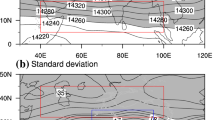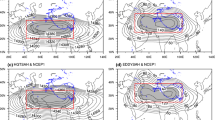Abstract
This study compares the decadal means of the seasonal (June–July–August (JJA)) mean geopotential heights available from the NCEP1 and ERA-40 reanalysis data in the Northern Hemisphere. The interdecadal changes in the South Asia High (SAH) intensity derived from the reanalysis data are also compared with ground-based radiosonde observations and atmospheric model outputs. The JJA mean geopotential heights in the 1980s are distinctly larger than the 1970s in NCEP1 over most of the regions in the Northern Hemisphere, while no obvious difference is observed in ERA-40. The interannual variation of the SAH strength is very close in the two reanalysis data, so that it is appropriate to utilize the reanalysis data to study the interannual variation of SAH strength after removing the interdecadal trend. However, the discrepancy in SAH intensity between NCEP1 and ERA-40 mainly exists on the interdecadal time scale. The SAH intensity in the NCEP1 was close to that in the ERA-40 before the late 1970s but became remarkably stronger after the late 1970s, leading to a much larger decadal strengthening during the period 1970–1990. Based on the six radiosonde observation stations in the area of the SAH, the results indicate that the decadal reinforcing in the SAH strength occurs around the mid-1980s. Thus, NCEP1 may overestimate the decadal shift in the SAH intensity around the late 1970s, while ERA-40 may underestimate it. Much attention needs to be paid when we use the reanalysis data to study the decadal variability of the SAH intensity.









Similar content being viewed by others
References
Durre I, Vose RS, Wuertz DB (2006) Overview of the integrated global radiosonde archive. J Clim 19:53–68
Ebisuzaki W, Kistler R (2000) An examination of a data-constrained assimilation. Proc. Second WCRP Int. Conf. on Reanalyses, WCRP-109, WMO/TD-985, Workfield Park. United Kingdom, WCRP. 14-17
Fu JJ, Li SL (2012) Intercomparison of the South Asian High in NCEP1, NCEP2, and ERA-40 reanalyses and in station observations. Adv Atmos Sci 5(3):189–194
Fu Q, Syukuro M, Celeste MJ (2011) On the warming in the tropical upper troposphere models versus observations. Geophys Res Lett 38:L15704
IPCC (2007) Climate Change 2007: The physical science basis. Contribution of Working Group I to the Fourth Assessment Report of the Intergoverment Panel on Climate Changed. S Solomon. D Qin, M Manning, Z Chen, M Marquis, K B Averyt, M Tignor and H L Miller. Cambridge University Press, Cambridge
Kalnay E, Coauthors (1996) The NCEP/NCAR 40-year reanalysis project. Bull Am Meteorol Soc 77(3):437–471
Kistler R, Coauthors (2001) The NCEP-NCAR 50-year reanalysis: monthly means CD-ROM and documentation. Bull Am Meteorol Soc 82(2):247–268
Li YH, Qing JM, Li Q, Luo WL (2012) The interannual (interdecadal) viaration characters of summer South Asia High and its effects on the drought over the east of southwest China. J Southwest Univ (Nat Sci Ed) 34(9):71–81 (in Chinese)
Liu BQ, He JH, Wang LJ (2009) The estibilishment process of South Asia High in Indo-China Peninsula from April to May and its possible mechanism. Chin J Atmos Sci 33(6):1319–1332 (in Chinese)
Liu BQ, He JH, Wang LJ (2012a) On a possible mechanism for southern Asian convection influencing the South Asian high establishment during winter to summer transition. J Trop Meteorol 18(4):473–484
Liu G, Zhao P, Wu RG, Chen JM (2012b) Potential flaws of interdecadal changes over eastern China around the early 1990s in the National Centers for Environmental Prediction–National Center for Atmospheric Research reanalyses. J Geophys Res 117, D02111. doi:10.1029/2011JD016327
Mason RB, Anderson CE (1963) The development and decay of the 100-MB. Summertime anticyclone over Southern Asia. Mon Weather Rev 91:3–12
Mitchell DM, Thorne PW, Stott PA, Gray LJ (2013) Revisiting the controversial issue of tropical tropospheric temperature trends. Geophys Res Lett 40:2801–2806
Mo KC, Wang X, Kistler R, Kanamitsu M, Kalnay E (1995) Impact of satellite data on the CDAS-reanalysis system. Mon Weather Rev 123:124–139
Po-Chedley S, Fu Q (2012) Discrepancies in tropical upper tropospheric warming between atmospheric warming between atmospheric circulation models and satellites. Environ Res Lett 7:044018
Qian YF, Zhang Q, Yao YH, Zhang XH (2002) Seasonal variation and heat preference of the South Asia High. Adv Atmos Sci 19(5):821–836
Qu X, Huang G (2012) An enhanced influence of tropical Indian Ocean on the South Asia High after the late 1970s. J Clim 25:6930–6941
Reiter ER, Gao DY (1982) Heating of the Tibet plateau and movements of the South Asian high during spring. Mon Weather Rev 110:1694–1711
Seidel DJ, Free M, Wang JS (2012) Reexamining the warming in the tropical upper troposphere: models versus radiosonde observations. Geophys Res Lett 39:L22701
Tao SY, Zhu FK (1964) The 100-MB flow patterns in Southern Asia in summer and its relation to the advance and retreat of the west- Pacific subtropical anticyclone over the far east. Acta Metero Sin 34:385–396 (in Chinese)
Tao SY, Li YF, Wen YP (1965) An preliminary study about atmospheric circulation on the upper troposphere and mid-to-lower stratosphere in Eastern China. Acta Meteor Sin 35:155–165 (in Chinese)
Upplala S, KÅllberg P, Angeles H (2004) ERA-40: ECMWF 45-years reanalysis of the global atmosphere and surface conditions 1957-2001. ECMWF Newsl Meteorol 101:2–21
Von Salzen K et al (2013) The Canadian fourth generation atmospheric global climate model (CanAM4). Part I: representation of physical processes. Atmos Ocean 51:1–22
Wu RG, Kinter J III, Kirtman BP (2005) Discrepancy of interdecadal changes in the Asian region among the NCEP-NCAR reanalysis, objective analyses, and observations. J Clim 18:3048–3067
Zhang Q, Qian YF, Zhang XH (2000) The interannual and interdecadal change of South Asia High. Chin J Atmos Sci 24(1):67–78 (in Chinese)
Zhang Q, Wu GX, Qian YF (2002) The bimodality of the 100 hPa South Asia High and its relationship to the climate anomaly over East Asia in summer. J Meteorol Soc Japan 80(4):733–744
Zhang PQ, Yang S, Kousky VE (2005) South Asian high and Asian-Pacific-American climate teleconnection. Adv Atmos Sci 22(6):915–923
Zhao TB, Fu CB (2009a) Intercomparison of the summertime subtropical high from the ERA-40 and over East Eurasia and the western North Pacific. Adv Atmos Sci 26(1):119–131
Zhao TB, Fu CB (2009b) Applicability evaluation for several reanalysis datasets using the upper-air observations over China. Chin J Atmos Sci 33(3):634–648 (in Chinese)
Acknowledgments
We thank two anonymous reviewers for their constructive suggestions and comments, which lead to a significant improvement in the paper. This work was supported by the National Natural Science Foundation of China Grants 41230527 and 41025017, and the Jiangsu Collaborative Innovation Center for Climate Change.
Author information
Authors and Affiliations
Corresponding author
Rights and permissions
About this article
Cite this article
Xue, X., Chen, W., Nath, D. et al. Whether the decadal shift of South Asia High intensity around the late 1970s exists or not. Theor Appl Climatol 120, 673–683 (2015). https://doi.org/10.1007/s00704-014-1200-5
Received:
Accepted:
Published:
Issue Date:
DOI: https://doi.org/10.1007/s00704-014-1200-5




